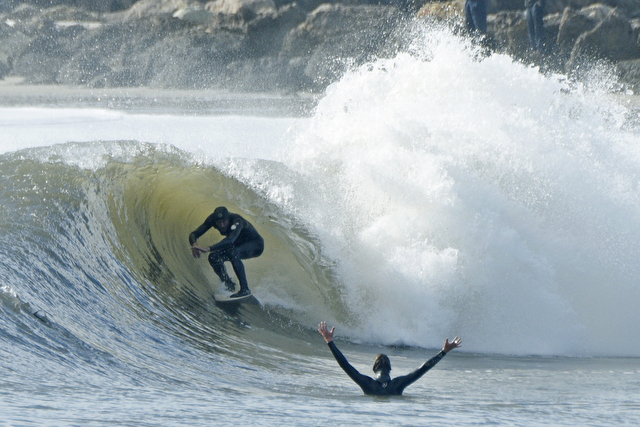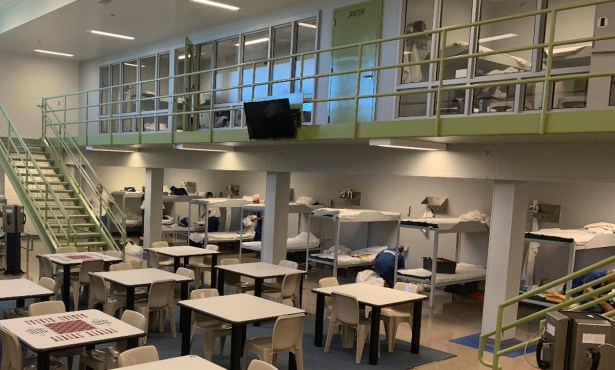Rain, Rain, Don’t Go Away
No Dent in Drought with Storms Mostly Missing Reservoirs

Last week’s El Niño storms may have dumped four inches of rain on the South Coast in relatively short order, but Santa Barbara city water czar Joshua Haggmark said it wasn’t nearly enough to generate runoff into either Lake Cachuma or the city’s Gibraltar Reservoir. At least two more storms will be necessary, he said, to even minimally replenish those desperately diminished reservoirs.
The rains were certainly welcome, Haggmark told the Santa Barbara City Council Tuesday, but contrary to custom, more water fell on the coastal plains than in the backcountry. That’s significant because the reservoirs on which Santa Barbara depends are located in the backcountry. Currently there’s only 18 inches left covering the bottom of the Gibraltar Reservoir — 9 percent of capacity — and Cachuma is down to 15 percent capacity.
Most of that, however, is not available for consumption purposes. In fact, there’s not enough usable water left in Cachuma to cover the 7,000 acre-feet a year that evaporates off the surface. As a result, the federal government, which owns the dam, is looking to make up what it reckons is an evaporation deficit of 4,000 acre-feet by taking water from the accounts held by the five water districts drawing their supplies from Cachuma. Those districts, Haggmark told the City Council Tuesday, are resisting fiercely.
Such is the weirdness of the fastest, hottest, driest drought to hit Santa Barbara County and California in recorded history. The good news, said Haggmark, is that Santa Barbara residents have exceeded their state-imposed conservation target of 25 percent by nearly 10 percent. That savings has stretched supplies, but the loss of sales has created a $4 million hole in reserves set aside for City Hall’s water system.
The City of Santa Barbara has hitched its water supply wagon to the $55 million desalination plant now under construction, scheduled to come online this October. That timetable might be slowed down, however, because large quantities of lead contaminants were discovered in the soil where construction crews are working. To make sure the project isn’t delayed — and to haul off 5,800 cubic yards of dirty dirt — the City Council authorized the expenditure of an additional $2.3 million.
There’s been much talk of the Montecito Water District entering into a partnership with the city over desalinated water, but so far, Haggmark said, no progress has resulted from such conversations. In the meantime, he was exploring various plans to inject highly treated wastewater into two of the city’s three groundwater basins. The United States Geologic Survey is putting the finishing touches on a study to determine how much recycled water — millions of gallons are flushed out to sea every day — can be banked in these basins.
Complicating matters, Haggmark said, has been the steady increase in water main failures, now hovering at about 90 a year. Many of the city’s cast-iron mains have reached the end of their lives, and the dramatic temperature changes that take place underground during winter months cause the pipes to expand and contract past their ability to expand and contract any more. To cover the costs of buying supplemental water from districts elsewhere in the state — 5,000 acre-feet in 2015 — the rate of main replacement was drastically curtailed.
Councilmember Bendy White asked Haggmark whether it was feasible to dredge much of the silt — deposited in the aftermath of the 2007 Zaca Fire — to create additional storage capacity. Before that fire, Gibraltar Reservoir had a storage capacity of 7,000 acre-feet, but enough silt was deposited to reduce that by 2,000 acre-feet. Haggmark said it would cost $100 million to restore Gibraltar’s lost capacity. The volumes of silt, he said, “are just massive.”
White expressed frustration that many of the lighter rains predicted for Santa Barbara last week never materialized. “It feels like we’re kind of whiffing on the rains here,” he lamented. Haggmark noted, as he has many times, that only two of the six past El Niño events delivered above-average rainfall. Or, as he said during an interview shortly before Tuesday’s council meeting, “It’s a long way to go to get back to normal.”



